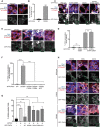Co-ordinated control of the Aurora B abscission checkpoint by PKCε complex assembly, midbody recruitment and retention
- PMID: 34143863
- PMCID: PMC8238520
- DOI: 10.1042/BCJ20210283
Co-ordinated control of the Aurora B abscission checkpoint by PKCε complex assembly, midbody recruitment and retention
Abstract
A requirement for PKCε in exiting from the Aurora B dependent abscission checkpoint is associated with events at the midbody, however, the recruitment, retention and action of PKCε in this compartment are poorly understood. Here, the prerequisite for 14-3-3 complex assembly in this pathway is directly linked to the phosphorylation of Aurora B S227 at the midbody. However, while essential for PKCε control of Aurora B, 14-3-3 association is shown to be unnecessary for the activity-dependent enrichment of PKCε at the midbody. This localisation is demonstrated to be an autonomous property of the inactive PKCε D532N mutant, consistent with activity-dependent dissociation. The C1A and C1B domains are necessary for this localisation, while the C2 domain and inter-C1 domain (IC1D) are necessary for retention at the midbody. Furthermore, it is shown that while the IC1D mutant retains 14-3-3 complex proficiency, it does not support Aurora B phosphorylation, nor rescues division failure observed with knockdown of endogenous PKCε. It is concluded that the concerted action of multiple independent events facilitates PKCε phosphorylation of Aurora B at the midbody to control exit from the abscission checkpoint.
Keywords: 14-3-3; abscission checkpoint; aurora kinases; midbody; protein kinase C.
© 2021 The Author(s).
Conflict of interest statement
The authors declare that there are no competing interests associated with the manuscript.
Figures




Similar articles
-
PKCɛ switches Aurora B specificity to exit the abscission checkpoint.Nat Commun. 2016 Dec 22;7:13853. doi: 10.1038/ncomms13853. Nat Commun. 2016. PMID: 28004745 Free PMC article.
-
The Aurora B specificity switch is required to protect from non-disjunction at the metaphase/anaphase transition.Nat Commun. 2020 Mar 13;11(1):1396. doi: 10.1038/s41467-020-15163-6. Nat Commun. 2020. PMID: 32170202 Free PMC article.
-
Cross-regulation between Aurora B and Citron kinase controls midbody architecture in cytokinesis.Open Biol. 2016 Mar;6(3):160019. doi: 10.1098/rsob.160019. Open Biol. 2016. PMID: 27009191 Free PMC article.
-
Building bridges between chromosomes: novel insights into the abscission checkpoint.Cell Mol Life Sci. 2019 Nov;76(21):4291-4307. doi: 10.1007/s00018-019-03224-z. Epub 2019 Jul 13. Cell Mol Life Sci. 2019. PMID: 31302750 Free PMC article. Review.
-
Knowing when to cut and run: mechanisms that control cytokinetic abscission.Trends Cell Biol. 2013 Sep;23(9):433-41. doi: 10.1016/j.tcb.2013.04.006. Epub 2013 May 22. Trends Cell Biol. 2013. PMID: 23706391 Review.
Cited by
-
Engineering Pyrrolysine Systems for Genetic Code Expansion and Reprogramming.Chem Rev. 2024 Oct 9;124(19):11008-11062. doi: 10.1021/acs.chemrev.4c00243. Epub 2024 Sep 5. Chem Rev. 2024. PMID: 39235427 Free PMC article. Review.
-
The Abscission Checkpoint: A Guardian of Chromosomal Stability.Cells. 2021 Nov 29;10(12):3350. doi: 10.3390/cells10123350. Cells. 2021. PMID: 34943860 Free PMC article. Review.
-
Preserving Genome Integrity: Unveiling the Roles of ESCRT Machinery.Cells. 2024 Aug 5;13(15):1307. doi: 10.3390/cells13151307. Cells. 2024. PMID: 39120335 Free PMC article. Review.
-
A Protein Kinase Cε/Protein Kinase D3 Signalling Axis Modulates RhoA Activity During Cytokinesis.Biomedicines. 2025 Feb 3;13(2):345. doi: 10.3390/biomedicines13020345. Biomedicines. 2025. PMID: 40002758 Free PMC article.
-
Cell cycle responses to Topoisomerase II inhibition: Molecular mechanisms and clinical implications.J Cell Biol. 2023 Dec 4;222(12):e202209125. doi: 10.1083/jcb.202209125. Epub 2023 Nov 13. J Cell Biol. 2023. PMID: 37955972 Free PMC article. Review.
References
Publication types
MeSH terms
Substances
Grants and funding
LinkOut - more resources
Full Text Sources
Molecular Biology Databases
Miscellaneous

